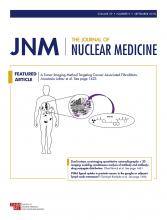Abstract
The study aims to investigate the presence of physiologic prostate-specific membrane antigen (68Ga-PSMA)-ligand uptake on PET in cervical, celiac, and sacral ganglia of the sympathetic trunk as a pitfall for lymph node metastases in prostate cancer imaging. Methods: Four hundred seven patients who underwent Glu-NH-CO-NH-Lys radiolabeled with 68Ga-gallium N,N-bis[2-hydroxy-5-(carboxyethyl)benzyl]ethylenediamine-N,N-diacetic acid (68Ga-PSMA-HBED-CC) PET (combined with a diagnostic CT) were retrospectively analyzed. The number of 68Ga-PSMA PET–positive cervical, celiac, and sacral ganglia was determined, and the configuration and SUVmax of each ganglion were measured. In addition, the configuration and SUVmax of adjacent lymph node metastases in the respective region (cervical, celiac, or sacral) were determined. Results: 68Ga-PSMA-ligand uptake above background was detected in 401 (98.5%) patients in any peripheral ganglia, in 369 (92%) patients in cervical ganglia, in 363 (89%) patients in celiac ganglia, and in 183 (46%) patients in sacral ganglia. The 68Ga-PSMA-ligand uptake was highest in celiac (mean SUVmax, 2.9 ± 0.8 vs. cervical mean SUVmax, 2.4 ± 0.6) and sacral (mean SUVmax 1.7 ± 0.5; both P < 0.0001) ganglia. Intraindividually there was a statistically significant but weak to moderate correlation between the 68Ga-PSMA-ligand uptake in cervical versus celiac ganglia (R = 0.34, P < 0.0001), cervical versus sacral (R = 0.52, P < 0.0001), and celiac versus sacral (R = 0.16, P < 0.05). The 68Ga-PSMA-ligand uptake was significantly more intense in adjacent lymph node metastases than the respective ganglia (cervical: 18.0 ± 16.2 vs. 2.4 ± 0.6, P < 0.0001; celiac: 13.5 ± 12.3 vs. 2.9 ± 0.8, P < 0.0001; sacral: 13.4 ± 11.6 vs. 1.7 ± 0.5, P < 0.0001). Furthermore, ganglia predominantly exhibit a band-shaped configuration (71.2%), followed by a teardrop (26.8%) and only rarely a nodular configuration (2.0%). Conversely, lymph node metastases are only rarely band-shaped (1.1%), but more often show teardrop (40.3%) or nodular appearance (58.6%) (P < 0.00001). Conclusion: 68Ga-PSMA-ligand uptake in ganglia along the sympathetic trunk as assessed by 68Ga-PSMA-HBED-CC PET represents an important pitfall in prostate cancer PET imaging. The 68Ga-PSMA-ligand uptake is higher in celiac ganglia than cervical or sacral ganglia, and the level of 68Ga-PSMA-ligand uptake seems to be patient-related. For the differentiation between lymph node metastases and sympathetic ganglia, both intensity of 68Ga-PSMA-ligand uptake and exact localization and configuration of the respective lesion should be examined carefully.
Footnotes
↵* Contributed equally to this work.
Published online Jan. 25, 2018.
- © 2018 by the Society of Nuclear Medicine and Molecular Imaging.







